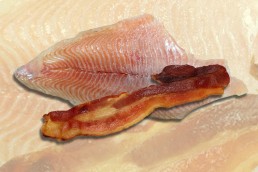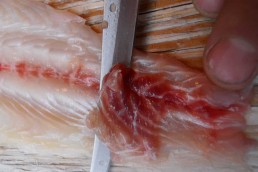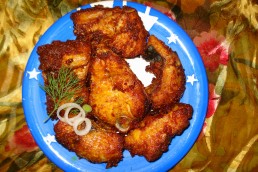From the Camp Cook: Bacon-wrapped Fish and More
SHARE THIS POST
It might be hard to remember summer when there is snow and ice. Although it may be cold and nasty out you can bring back a bit of warm weather by taking a pack of fish out of the freezer. Those caught in the summer help us remember those warm days. Warmer weather is still months away, but a meal of fish can chase those winter blues away.
Parmesan-baked fish
This is ideal for walleyes or bass or any fish with a thicker fillet. First, preheat the oven to 350 degrees. Thoroughly dry the fillets on paper towels. Mix plain breadcrumbs with grated Parmesan cheese. Brush the fillets on both sides with olive oil and roll in the dry mixture. Spray a cooking pan with cooking spray. Lay the fillets in the pan and shake more Parmesan cheese on top of the fillets. Bake for about 25 minutes. The last time I did this I just had two fillets, so this cooking time is good. For more added in the pan, add cooking time, but watch them. Make sure fillets flake with a fork when done. Serve. I salt my fish when I’m ready to eat them but you could also add salt and pepper before rolling them in the breadcrumbs and Parmesan cheese.
Bacon-wrapped fish
How can you go wrong with fish and bacon? I got this recipe from Jan Holmes of Rosemount, Minn. She brought this back from a fishing trip to Canada last summer and made it as an appetizer. Again, this is best with thicker fillets like a walleye or a bass. First, lay out strips of bacon. Brush one side with Dijon mustard. Cut the bacon strips in half. Cut fillets into 1-by-2-inch strips. Roll the pieces of fish in bacon with the mustard side on the inside. Peg with toothpicks. Place on the grill. If using gas, grill on medium heat. Turn often, and when the bacon is done so are the fish. If you want to make them in the oven, cook at 350 degrees and place the bacon-wrapped fish strips on a rack with a cookie sheet. Bake until the bacon is done and serve.
Are you enjoying this post?
You can be among the first to get the latest info on where to go, what to use and how to use it!
Dips
I used these two dips with my bacon-wrapped walleye bites. However, they can be used with any fish recipe or as a substitute for tarter sauce. For the first dip, take 4 heaping spoons of mayonnaise and squeeze half a lime on top. Stir until the lime is completely mixed with mayo. For the second dip, mix Tajin Classic Seasoning with 4 heaping spoons of mayonnaise. The seasoning is primarily a mixture of chili peppers, sea salt and dehydrated lime juice. (Tajin is a Mexican spice and can be found in grocery or specialty stores or online.) Mix the seasoning with the mayo until the dip is a light orange color.
Mother’s Vinegar Coleslaw
My mother Alice is the best cook I know. At 92, she doesn’t cook much anymore but her legacy is preserved in the recipes she collected over her lifetime. And now her children and grandchildren use them. For her vinegar coleslaw, first mix 12 tablespoons of sugar, 12 tablespoons of vinegar, 8 tablespoons of salad oil and 2 teaspoons of salt and a couple shakes of pepper. Stir it all together until the sugar is dissolved. Pour over a couple bags of store-bought coleslaw mix. Let it sit for an hour or two, stirring every now and then. Make sure cabbage mix is coated. If you want a smaller salad adjust the amounts. According to Mother’s recipe card, which I am using as I’m writing this, she adds a little thinly sliced onion and carrot to the coleslaw. My wife has been making Mother’s Vinegar Coleslaw for years and she adds half a green pepper. Every fall in South Dakota I put together a fish fry for the family whose farm we pheasant hunt on. Four years ago I started bringing Mother’s Vinegar Coleslaw and it has drawn rave reviews. The fish fry would not be the same without it.
Cooking with lard
Most of us who grew up in the 1950s and ‘60s remember our mothers cooking with lard; everyone did in those days. I also remember my mother having a can set aside where she collected bacon grease to use later in cooking. For years, the vegetable oil people attacked lard as being really bad and eventually people moved away from using lard. However, there is nothing wrong with using lard from time to time, especially when frying fish. I know a chef from a prestigious hotel in Florida who told me they keep all their bacon fat and use it in some of their recipes. Lard can be found in any grocery store, but you might have to ask for help in finding it. I use it just like vegetable oil and put enough of it in a pan and melt it so it covers one side of the fish fillet. Once the first side is done, I’ll flip it over and cook the other until the edges are brown. Lard has it own taste and is adequate for an occasional replacement for vegetable or olive oil or butter.
MWO
SHARE THIS POST
Did you enjoy this post?
You can be among the first to get the latest info on where to go, what to use and how to use it!
Mike Yurk
Mike Yurk grew up in Oshkosh, Wis., where he first started writing about the outdoors. A retired Army officer, he is now a full-time, freelance outdoor writer. He has written more than 1000 articles for outdoor publications and published 12 books on outdoor sports. He lives in northwestern Wisconsin where he has found some of the best bass fishing in the country.



